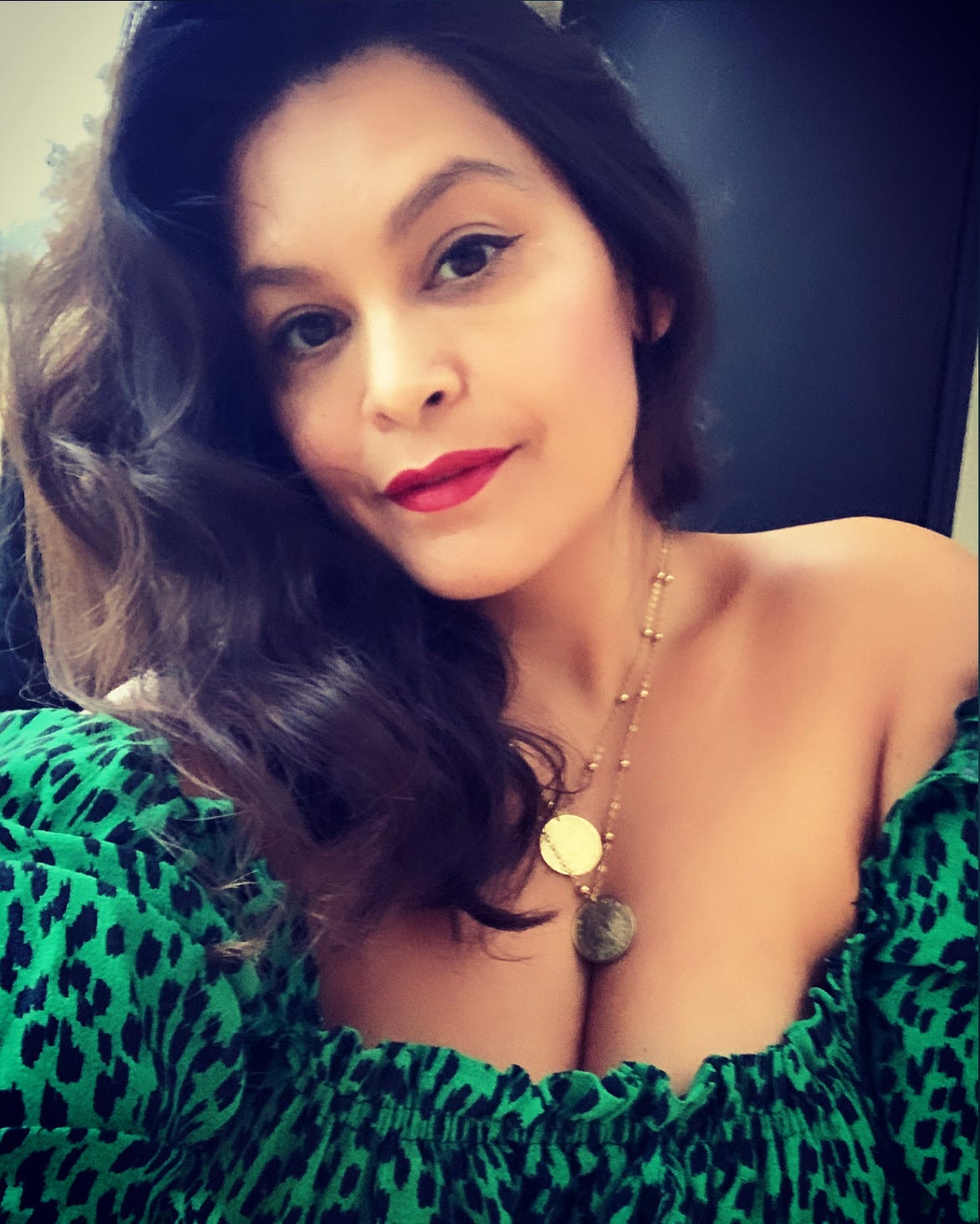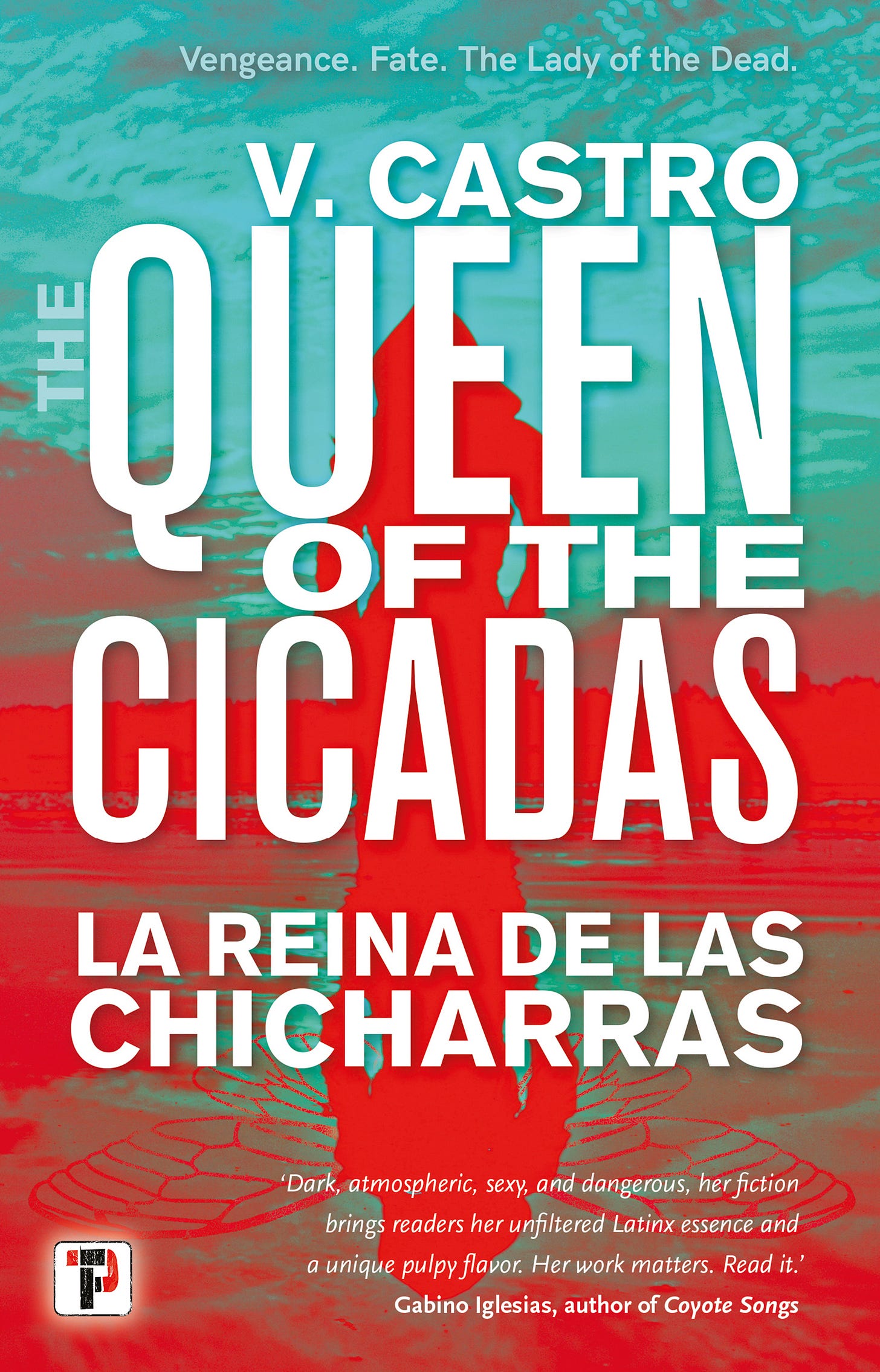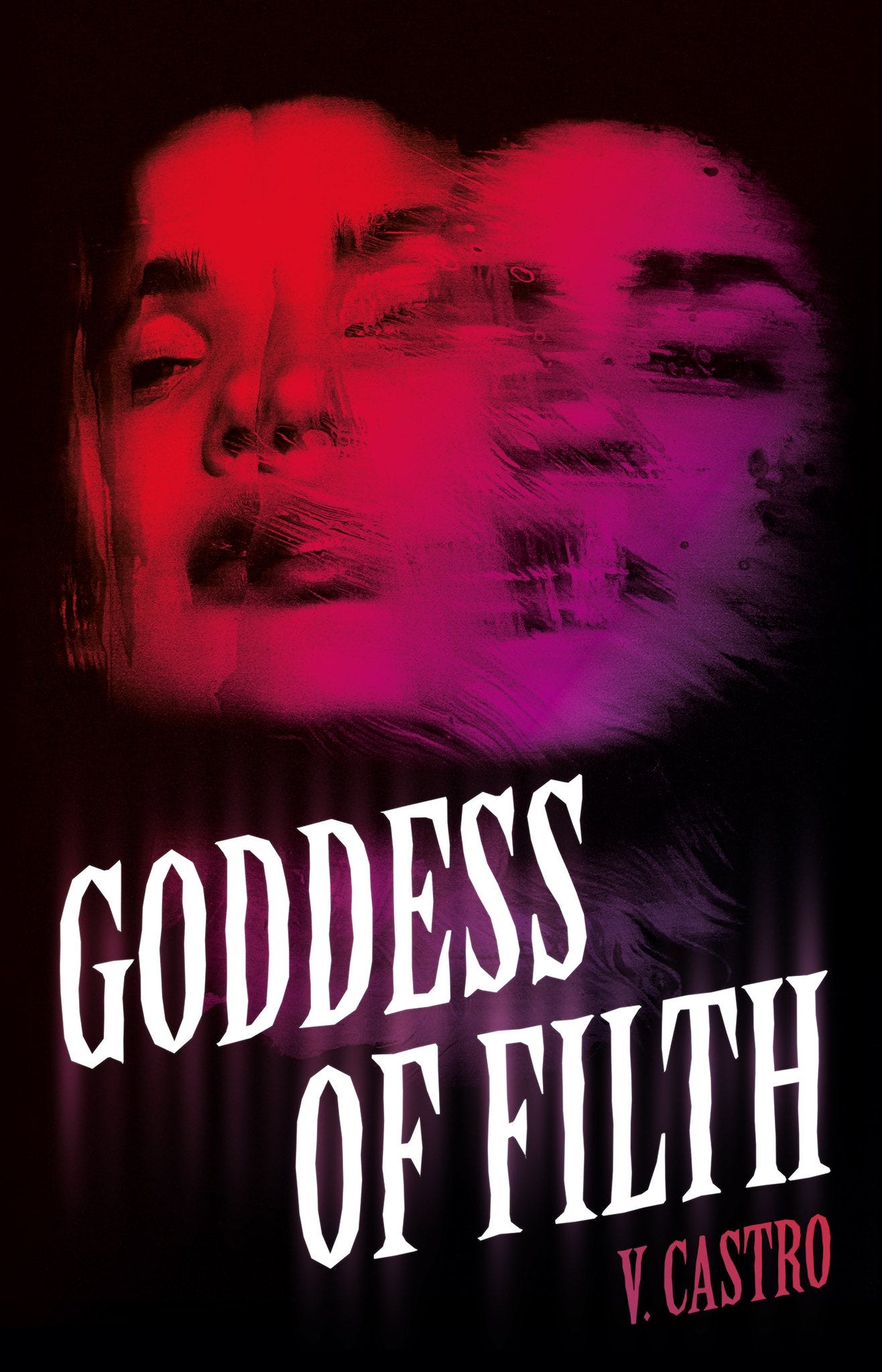In The Veil’s first feature on folk horror, artist and author Andy Paciorek (citing author Adam Scovell) summarized the genre’s key elements: “location; isolation (geographical and/or cultural); skewed moral or belief systems; and a ‘Happening’ that could be supernatural or violent.” Landscape, above all, and the unique atmospheres and indigenous beliefs that arise from natural spaces, is primary to folk horror.
Those elements abound in Violet Castro’s extraordinary debut novel, The Queen of the Cicadas, yet it reads like no other work of folk horror I’ve come across. The novel follows two storylines that eventually converge in what is definitely a “supernatural and violent Happening.” The first plot line recalls the horrific torture and murder of a Mexican migrant worker in Texas in 1952; the second follows a contemporary Mexican-American woman, Belinda, who attends a wedding at the site of the notorious murder, a former cotton farm now converted into an event space. Belinda befriends the farm owner and is drawn into the mystery surrounding the unsolved murder and the urban myth since passed down through generations of Mexican migrant workers: La Reina de las Chicharras. In the whispered stories, the migrant worker, just before she died, called upon the aid of Mictecacíhuatl, the Aztec Queen of the Dead, who then wreaked revenge on the murderers (in which chicharras or cicadas played a gruesome role).
However, in The Queen of the Cicadas, Mictecacíhuatl is a very different “monster” from the brutal pagan deities and avenging ghosts of much European and Asian folk horror. Violet Castro explains why.
The Veil: How did you come to be a horror fan?
Violet Castro: I’m Mexican-American, and we have a lot of scary folk tales and urban legends, so I grew up with stories of La Llorona and La Lechuza. As a small child, hearing these frightening tales—I just loved them. I loved hearing about these otherworldly creatures. I was drawn to the dark. Then I started watching films, and, well, things were different back in the day! I started watching those movies when I was way too young. This was the time of Blockbuster Video, so you would go in and see all of the covers of the horror movies, some of them quite bloody and graphic, and you would say, Oh, gosh, I want to see that! So the progression to horror movies was just a natural thing that happened for me. It was a blending of my culture and the timing of when I grew up.
The Veil: And was there a particular experience that made you want to move from being a horror fan to a creator of the thing you loved?
VC: My mom recently sent me a ton of drawings and little books that I wrote going right back to when I was six years old. These are stories that I wrote with really horrible drawings, you know? And I thought, This kid is disturbed! If this was my kid, I would be worried. But I can see that it was just me being me, even back then. I remember being a girl and creating those things and it just feeling natural. By the time I got to College I’d already had so many powerful life experiences that I knew I wanted to write about them, so much that my friends would joke, Oh, oh, this is going into the book! But it’s true that timing is everything, and I had to reach a point in my life where I was missing so much, I was so unhappy and hurting that I needed more. I needed healing and so I just started writing, with lots of hopes but with little idea of where it would lead me. That was in 2016 and I haven’t stopped since.
The Veil: What were you doing before 2016?
VC: I became a certified personal trainer and I was a full-time mother. Motherhood is a theme in all of my stories. No shade to full-time parents, but part of me was always like, What, this is it? This is my life?
The Veil: You really put a lot into The Queen of the Cicadas. You explore the history of Mexican migrant workers in America, you have urban legends, you have Aztec cosmology: how did all of those things come together in a novel? Was there something in the story idea that made you think, This could be a novel?
VC: I remember the moment it happened! It was announced that Candyman was going to be remade and reclaimed by Black creators. And I was like, “That’s so amazing! I would love to write a Latinx version of Candyman.” There are so many urban legends, especially in Texas where I grew up. My great-grandparents were migrant workers and we have a beautiful photo of them, my great-grandfather Serafin and great-grandmother Elodia. I spent a lot of time with my great-grandmother when I was growing up—she raised my mother and her siblings—so I knew that story. Then, like I said, I’d been in a very dark place for a while and that’s how I wrote the opening of the novel, where Belinda asks, “Have you ever been in a place so devoid of light you can no longer see your hands in front of your face?” From there it just flowed, it happened. It turned into a novella, and I couldn’t sell it to any publishers, so it sat there. Then (the novel) American Dirt came out, and that spurred me on to grow it (The Queen of the Cicadas) into a novel. Finally, Flame Tree (Press) said yes to publishing it after it was rejected so many times.
The Veil: Yes, American Dirt: that must have angered you…
VC: That author got a million dollars! For bullshit! People of colour have been trying so hard for so long to tell our own stories, but we have been systematically shut out and put into little corners, and then this white author gets a million dollars for a novel about Mexican migrants. To see her publisher hosting a dinner with barbed-wire centre pieces and she is showing off her nail polish with barbed wire and is on all of these TV shows saying, Look at me, look at me, while pretending to be Puerto Rican—it was a slap in the face.
The Veil: So often in horror, when you introduce your monster or your serial killer or your ghost to the reader or viewer, you can presume a certain level of cultural familiarity with that figure. And that familiarity triggers all manner of creepy associations, which the author or director can then exploit. But you were working from scratch in many ways, because you can’t presume that readers will know the identity of Mictecacíhuatl, the Queen of the Dead in Aztec cosmology, who plays such a key role in the novel. Was it difficult for you as an author to familiarize readers with that cosmology without resorting to long expository passages?
VC: As a woman of colour, you’re damned if you do and damned if you don’t anyways. You might be ignored, you might not be, so what did if I have to lose by doing this? The story and characters just flowed. Having never had the opportunity to tell these stories, I just went with it. I’m never going to set myself apart from my counterparts by telling someone else’s stories. There is a risk in that, and a struggle, because you want the same recognition and opportunities. But these stories have to be told. No offence to Stephen King, but are we going to be reading stories like his forever and a day? How many remakes do we need on our screens? Our stories should be told. They have value and they matter. And you know what? They’re different! I don’t hear anyone complaining about another story about Odin or other European gods, so why not keep telling our stories?
The Veil: In a recent interview you said, “People from marginalized communities should not have to flex to show they belong or are worthy. We can write pulp, crime, horror, science fiction, erotica, romance. Literary fiction is not always best.” What stories, and what are audiences, do you think can best be engaged by fiction that is not necessarily considered “literary” in some circles?
VC: In my community, we love horror, we love crime, we love all of it, yet we are not valued as customers. That’s really pathetic and sad. I believe in the saying, If you build it, they will come. With genre fiction, especially dark fiction, you can get deep into real-life subjects and talk about difficult subjects in a way that people can digest and relate to. I have so many women who connected with Goddess of Filth, my novella. It also has a deity, an amazing deity who is a sin eater. I’ve had so many young women and women my age write to me and say, “I saw myself in that story. I feel so seen, so represented and comfortable. Thank you so much for writing this.” When that happens, I know I’m on the right track. There are lots of people from marginalized communities who thrive in literary fiction, but that’s not me. I don’t want to be policed by the Literary Police. I feel that there’s more freedom in genre. I like to break rules. I like to say, Fuck it. I want to write what I want, be what I want, because other writers have been doing that forever, so why can’t I?
The Veil: There are also folk horror elements in The Queen of the Cicadas, in that an ancient deity is awakened by a modern, urban protagonist. You have turned that trope on its head, though, by making the deity in many ways a saviour figure, at least for the women who ask for its protection. Were you aware from the beginning that you wanted to make your "monster" a force of regeneration for the heroine?
VC: In my culture, death is not the end. As I got older and got more in touch with my culture and with my own writing, and as I went through a lot of different life experiences, I began to see that we often experience death—a death in relationships, a death in our pre-conceived notions of ourselves, a death in our jobs and in what we hold dear. These are just precursors to physical death, but no matter what, a part of us always lives on. So when I was writing The Queen of the Cicadas, I knew I wanted death to also be the beginning. Sometimes parts of us have to die to move forward or create a new beginning of something greater. But the story evolved naturally with the characters. I didn’t really think about it.
The Veil: You also said that when you were growing up, “There were no Latina final girls, villains, heroes, writers, directors of storylines that reflected the horror of growing up Chicana.” Do you feel like that’s changed for the better?
VC: We’re trying to change it. You’re seeing a lot more Latinx directors and writers getting their stuff out there on TV and film, and writers getting more opportunities for book deals. It’s amazing and it’s exciting, but again, we have to keep working and chipping away. Every day I pray for more!
The Veil: Does that come with an extra sense of responsibility? I mean, non-marginalized writers bring with them a whole infrastructure not available to you. For instance, a British author who writes a haunted house story has over two hundred years of established tropes to draw upon. You also have a rich history of stories and histories to draw upon, but readers probably won’t know them.
VC: Yes, that’s one-hundred percent correct! That’s why we have to be up front with our stories so people won’t just see them as something from a history book. We have to shine our light and cause change in a really broken world, a fractured world. For me, writing stories can be unifying, because we react to each other and the world in such a fractured way. That’s because of fear. It’s a fear-based reaction. And even though I am writing from a place of fear, I’m helping to pull back the curtains, to expose the fear by putting it in your face. So I am happy to have that responsibility and to help out any way I can. But it can be hard sometimes. On social media I try to help lift people, but for me, the best thing I can do is to try to break as much new ground as I can and go as far as I can. That will help to lift people. They can look at me and say, “She did it, and so can I.” We have to set new precedents, and I can only do that by writing. I want to unify people by making them scared!
The Veil: Yes, being a writer requires a lot of privacy and alone time. If you spend six hours a day on social media and giving speeches, your creative well might run dry. Now that you are getting a lot of media attention, are you finding it hard to maintain the necessary balance and isolation to keep doing what you do?
VC: No, because I’m on my own, so I have a lot of time to do what I need to do. More than anything, I need to time to rest, to go on walks and get away. Otherwise I just sit and look at my computer screen! No one’s forcing me to.
The Veil: Who do you count as your influences?
VC: Every single horror film from the eighties! Even the bad ones. And stories from my childhood, the urban legends, and when I was a young reader there was Sandra Cisneros and Isabelle Allende—both very literary! Then there’s all the horror writers, Stephen King and Clive Barker at the top of the list of course. But as writers, we are just conduits. I really don’t know where the stories are coming from. We’re humans, and we have so much stimulation from so many places, and it goes inside us and wants to come out. I’m just the conduit for that.






